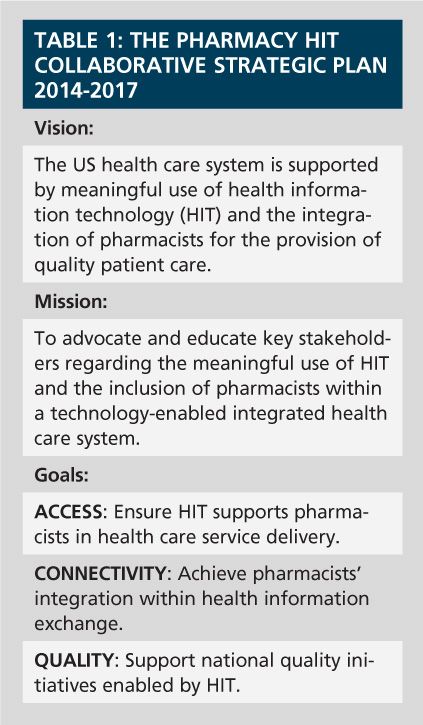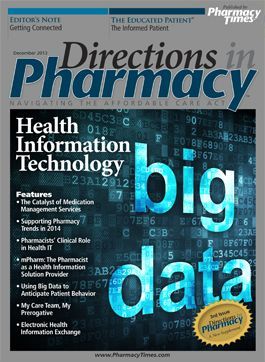Publication
Article
Pharmacy Practice in Focus: Oncology
Pharmacists' Clinical Role in Health IT: Access, Connectivity, and Quality
Author(s):
Standardizing the steps of medication therapy management can help facilitate the seamless exchange of clinical information.

Standardizing the steps of medication therapy management can help facilitate the seamless exchange of clinical information.
Imagine somebody being released from the hospital and the reconciled medication list is electronically available with a medication action plan (MAP) at the pharmacy prior to their showing up to pick up their discharge medications.
The pharmacist would be able to counsel the patient, document any feedback, and reinforce discontinuation of duplicate prescriptions or interaction with non-prescription medications. These actions would help to reduce the possibility of hospital readmission due to medication errors. All this documentation would be electronically exchanged with other health care providers and sent to the patient’s electronic personal health record (PHR) through a health information exchange (HIE).
Pharmacists working in all types of practice settings collect, document, and exchange clinical information differently. Even the pharmacy management systems we use are individually geared to our own work flow. Other care providers, especially physicians and hospitals, are moving toward a standard electronic way of capturing and exchanging health information. A good analogy is how we receive e-mails. Each person uses their own e-mail system (Outlook, Google, Microsoft), and although we write an e-mail in these proprietary systems, somehow we get the e-mail and can read it. This is because the e-mail is transported using standards.
In pharmacy, we see this with standard electronic claims, electronic prescribing, electronic submission of immunization/registry information, and the formation of state HIEs to transport the standard message (eg, laboratory data, discharge summaries, patient care summaries). As in our e-mail analogy, imbedded within the e-mail we receive attachments (eg, word documents, PDFs, spreadsheets, pictures). These structured documents follow standards so they can be read by any computer system that has the functionality to read the attachment. The same is true for the HIT environment.
The Pharmacy HIT Collaborative
In the fall of 2010, 9 pharmacy professional organizations formed the Pharmacy HIT Collaborative (www.pharmacyhit.org). In the following year, the collaborative published “The Roadmap for Pharmacy Health Information Technology Integration in U.S. Health Care” (www.pharmacyhit.org/pdfs/11-392_RoadMapFinal_singlepages.pdf), which outlined goals, objectives, and strategies pharmacy as an industry should follow through 2015. This year, the collaborative vision, mission, and strategic focus are around pharmacists’ clinical role in health information technology (HIT) through access, connectivity, and quality.

To be successful, we need to standardize the steps of medication management, and then use technology solutions to collect information and document that information so that others outside of our pharmacy management system can understand the care that the pharmacist provides. Nationally, through the work of the Office of the National Coordinator for Health IT (ONC), incentives have been paid to physicians and hospitals to adopt an electronic health record (HER) in a meaningful way. This includes using standardized electronic structured documents and standardized coding to document capture the terminology in a consistent manner.
The time is ripe for pharmacy to follow ONC’s national electronic initiatives of moving standardized clinical data between health care providers and engage the patients in their care. One of the first steps was to push the adoption of e-prescribing. A useful article can be found in “Where in the US are EHR and e-prescribing adoption strongest and weakest?” (Baum S. Where in the US are EHR and e-prescribing adoption strongest and weakest? http://medcitynews.com/2013/08/where-in-the-us-are-ehr-and-eprescibing-adoption-strongest-and-weakest-infographic/#ixzz2f9zqw5K3. Published August 1, 2013.)
Pharmacists do so much more that just accept an electronic prescription for dispensing. According to 2013 MTM Digest, “Medication therapy management is on a growth curve with 70% of providers who replied stating that they have more patients receiving MTM in 2012 than in 2010.Thirty-four percent of providers also say that they expect an increase in the number of contact opportunities in 2013.” (www.pharmacist.com/sites/default/files/files/MTMDigest_2013.pdf). Now is the time to standardize the process and prepare the pharmacist providing MTM interventions to be electronically exchanged with other health care providers and patients.
Through National Council for Prescription Drug Programs (NCPDP), the collaborative is working on structured clinical documents that will be imbedded in an e-mail-like transport system, mainly an HIE. These standardized electronic structured documents will transport pharmacy care notes using an electronic progress note standard, MAP following an electronic care plan standard, and pharmacy transition of care document following continuity care document standard. Since these electronic structured documents follow standards, they can be exchanged with any health care provider’s EHR and even the patients themselves through a PHR.
The pharmacy management system is the missing link that has the ability to connect with an HIE and the functionality to read and create these standard electronic structured documents. The collaborative worked with the standards development organizations defining a standard pharmacist EHR that has this ability and functionality to collect and exchange electronic standard structured documents. As pharmacists, we need to think about the process of care—how we collect, document, and exchange clinical information with other health care providers and the patients.
Creating a Standard
The Pharmacy HIT Collaborative continues to take the lead to create a standard for system vendors to use an electronic version of the MTM Medicare Part D January 2013 “take away” document. These standards follow the same standards all eligible providers receiving the incentives for the meaningful use of the EHR are mandated to use to exchange clinical documents (eg, patient care summaries, discharge summaries, and care plans). The Centers for Medicare & Medicaid Services (CMS) Medicare Part D 2014 Call Letter encourages Part D plans to adopt the use of the electronic version of the “take away” structured document and the use a set of standardized clinical terms (SNOMED CT codes). (www.cms.gov/Medicare/Prescription-Drug-Coverage/PrescriptionDrugCovContra/Downloads/Memo-Contract-Year-2014-Medication-Therapy-Management-MTM-Program-Submission-v040513.pdf; pages 11-12.)
CMS recognizes the importance of using standardized codes as a way to demonstrate the value of MTM services for quality measurement. The same way pharmacists use National Drug Codes numbers to electronically document which medication was dispensed, these MTM SNOMED CT codes will be used to document the clinical care provided by pharmacists providing MTM services.
Now is the time for pharmacists to take their place in electronically documenting and exchanging clinical information using standardized HIT. With the support of the 9 pharmacy professional organizations, the Pharmacy HIT Collaborative is focused on ensuring that HIT supports pharmacists in health care services delivery, achieves pharmacists’ integration with health information exchange, and supports national quality initiatives enabled by HIT. These goals of access, connectivity, and quality will secure the role of pharmacists as a key part of patient care.
Shelly Spiro, RPh, FASCP, is executive director of the Pharmacy Health Information Technology (HIT) Collaborative and president and chief executive officer of Spiro Consulting, Inc. She has more than 30 years of experience in pharmacy and has worked as a pharmacy clinician, teacher, operations manager, and corporate administrative executive. Shelly is the Work Group 10 Pharmacy Professional Services co-chair for the National Council for Prescription Drug Programs and has served as president of the American Society of Consultant Pharmacists. She is a registered pharmacist in Illinois, Colorado, Nevada, Virginia, and Texas.







